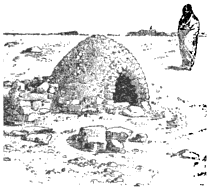Horno facts for kids


A horno (pronounced OR-noh) is a special outdoor oven. It is made from mud and adobe (a type of sun-dried brick). Native Americans and early settlers in North America used these ovens. The horno has a unique beehive shape. It uses wood to create heat for cooking.
Contents
What is a Horno?
A horno is basically an outdoor oven. It is built using natural materials like mud and adobe. The word "horno" comes from the Spanish word for "oven" or "furnace." This Spanish word itself comes from the old Latin word furnus.
How Hornos Work
Using a horno is a traditional way to cook. First, a fire is built inside the horno using wood. The fire heats the oven to a very high temperature. Once the oven is hot enough, the burning wood, called embers, and the ashes are carefully removed. Then, the food is placed inside the hot oven to cook.
Cooking Different Foods
Hornos can cook many types of food. For baking bread, the bread is placed inside after the embers are removed. For cooking corn, the embers are often doused with water. This creates steam, which helps to "steam-cook" the corn. When cooking meats, the oven is heated until it's extremely hot, sometimes called "white hot." This can be around 650 degrees Fahrenheit (about 343 degrees Celsius). The hot coals are then moved to the back of the oven. The meat is placed inside. The oven's smoke-hole and door are sealed with mud to keep the heat in. A large turkey, for example, might take 2½ to 3 hours to cook this way.
History of the Horno
The idea for the horno oven first came to the Iberian Peninsula (where Spain and Portugal are today). It was brought there by the Moors, who were people from North Africa. The design was quickly adopted by the Spanish. They then carried this oven design to all the lands they explored and settled. This is how the horno came to North America.
Where Hornos are Used Today
Even today, hornos are still used in parts of the Southwestern United States. You can find them in places like New Mexico and Arizona. They are an important part of the culture and cooking traditions in these areas. Many people still use them to bake bread, cook meats, and prepare other traditional foods.
Horno Facts
- The beehive shape of the horno helps to spread heat evenly inside.
- Sealing the door and smoke-hole with mud helps to trap the heat. This makes the oven very efficient.
- Hornos are a great example of how people used natural materials to create useful tools for daily life.

